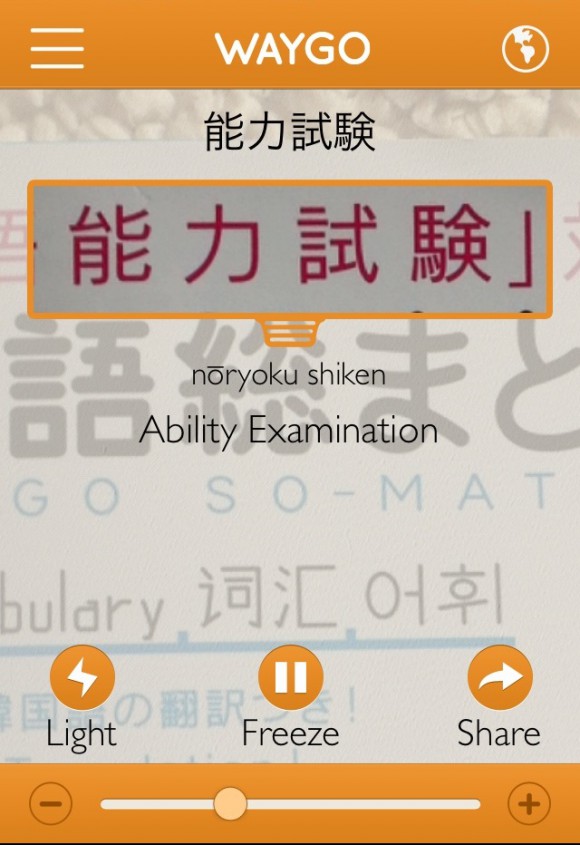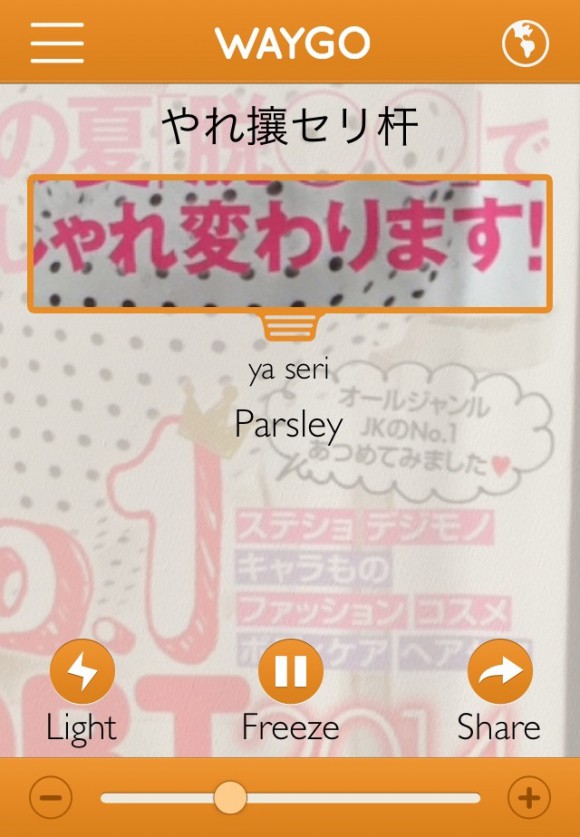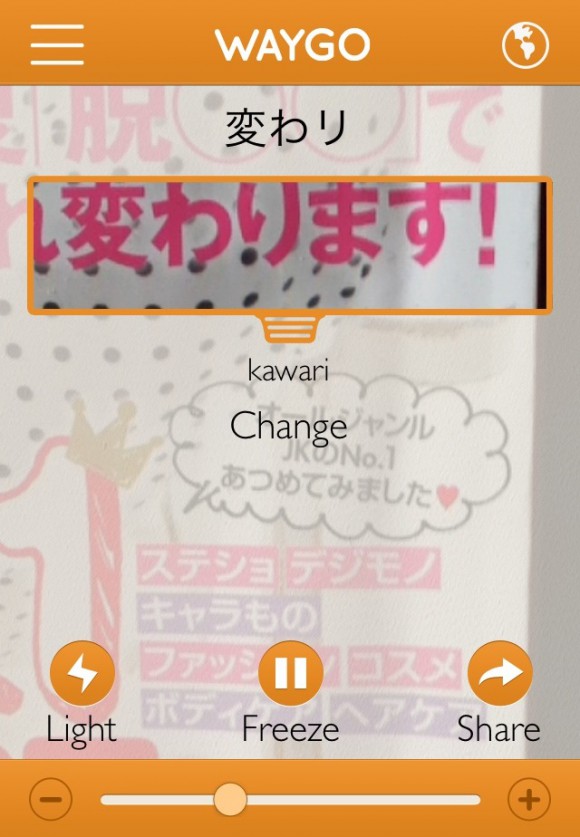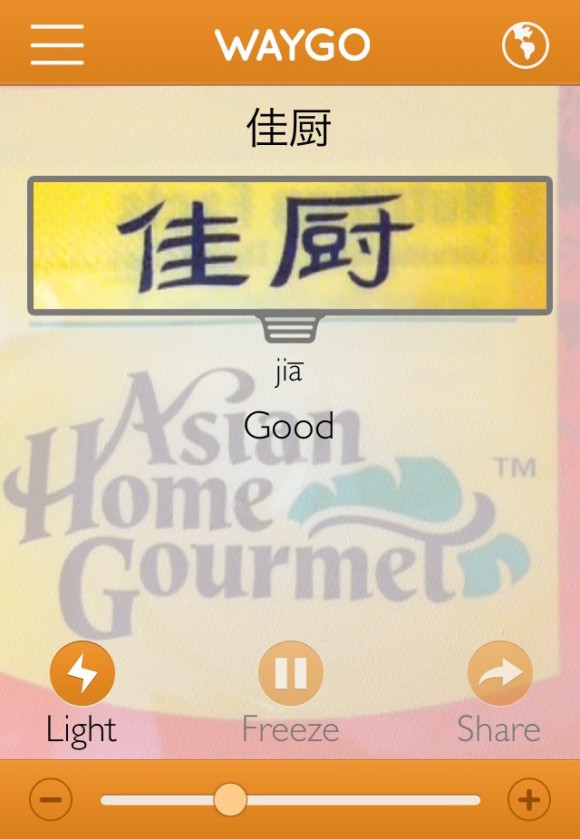
With their complex writing systems, getting around in Japan or China can be stressful for even the most seasoned of tourists. Sure, you could carry a travel dictionary in your pocket while you go sightseeing, but how are you supposed to look up all those funny looking sticks and squiggles when you don’t even know how to pronounce them? Often the locals try to be helpful by providing an English translation, but there are reasons why that doesn’t always work out. If only there was a way to just wave your magic smartphone over some unintelligible text and have it provide a reliable translation on the spot. Well, as we discovered over at Shanghai List, there’s an app for that.
Translator/Dictionary Chinese and Japanese by Waygo is available via the App store and Google Play and claims to reliably translate Japanese or Chinese by simply asking you to focus your smartphone’s built-in camera on the text in question and watch as the translation pops up, complete with pronunciation guide. The really cool thing about Waygo is that you don’t even need to be connected to the internet for it to work! Forget about paying through the nose for expensive pocket wifi rental or dashing from one internet cafe to the next, because this app’s got you covered!
Here’s a demonstration of the app in action:
Hmm, it looks pretty good, but we still weren’t 100 percent convinced – there’s a lot of apps out there that claim to provide accurate translations of Chinese and Japanese after all, so the only way to gauge the usefulness of this app was to… download the trial version and try it out for ourselves! The free version of the app limits you to 10 translations per day, which we managed to use up fairly quickly.
First, we started off with Japanese. Switching between languages is as easy as swiping left to the language menu and picking one or the other.
Let’s see what Waygo makes of our Japanese textbook!
▼Hey! Not bad, not bad at all!
Okay, what about this random magazine we had lying around?
▼ Um… not quite…
But hang on a sec… a little bit of re-positioning and waiting, and…
▼There it is!
We then switched to Chinese mode and set the app loose on a packet of hot and sour soup.
▼ Good. Just good? That all? You sure? We thought the second character was “kitchen” but the app was reluctant to elaborate further.
The app also failed to recognize some of the more elaborate, calligraphy-style font on the back of the soup packet. To get the best results, it’s probably better to stick to plain text and avoid handwriting altogether. Upping the lighting and re-positioning a few times also helps, but it seems that if you’re not sure where one word ends and the other begins, you might position your camera in the wrong place and wind up with complete gibberish. Or parsley.
The app certainly seems like it would come in handy for deciphering simple signs and restaurant menus, but for a more in-depth translation you’re probably better off asking someone who knows both languages. What do you think of translation apps like this?
Source: Shanghai List
Images: MFinChina, RocketNews24





 Yamaha releases engine-to-Japanese translation app, we peer into the minds of celebrity cars
Yamaha releases engine-to-Japanese translation app, we peer into the minds of celebrity cars Kyoto study finds nearly 500 translation errors for foreign tourists, new guidelines released
Kyoto study finds nearly 500 translation errors for foreign tourists, new guidelines released You beautiful fatty! — Doraemon character teaches us to speak nicely with new smartphone app
You beautiful fatty! — Doraemon character teaches us to speak nicely with new smartphone app Six (and a half) essential resources for learning Japanese
Six (and a half) essential resources for learning Japanese Japan Airlines debuts airport translation panels, translation error quickly results
Japan Airlines debuts airport translation panels, translation error quickly results 7-Eleven Japan’s ramen-cooking robot whipped us up a bowl of noodles【Taste test】
7-Eleven Japan’s ramen-cooking robot whipped us up a bowl of noodles【Taste test】 7 great places to see Mt. Fuji from without having to climb it
7 great places to see Mt. Fuji from without having to climb it Survey finds more than 70 percent of Japanese children have an online friend
Survey finds more than 70 percent of Japanese children have an online friend Disillusionment at Tsukiji’s tourist-target prices led us to a great ramen restaurant in Tokyo
Disillusionment at Tsukiji’s tourist-target prices led us to a great ramen restaurant in Tokyo Cyberpunk anime meets traditional culture in Ghost in the Shell gold leaf Japanese changing screens
Cyberpunk anime meets traditional culture in Ghost in the Shell gold leaf Japanese changing screens Starbucks Japan ready to get Year of the Horse started with adorable drinkware and plushies【Pics】
Starbucks Japan ready to get Year of the Horse started with adorable drinkware and plushies【Pics】 New Japanese menstrual product seeks to help women spot unidentified iron deficiencies
New Japanese menstrual product seeks to help women spot unidentified iron deficiencies Survey says osechi New Year’s food differs according to each region in Japan
Survey says osechi New Year’s food differs according to each region in Japan Tokyo’s Shinjuku is looking very different with its giant westside skyscraper torn down【Photos】
Tokyo’s Shinjuku is looking very different with its giant westside skyscraper torn down【Photos】 Tokyo Station staff share their top 10 favorite ekiben
Tokyo Station staff share their top 10 favorite ekiben Japan may add Japanese language proficiency, lifestyle classes to permanent foreign resident requirements
Japan may add Japanese language proficiency, lifestyle classes to permanent foreign resident requirements Lacquerware supplier to emperor of Japan and Pokémon team up for new tableware
Lacquerware supplier to emperor of Japan and Pokémon team up for new tableware Starbucks Japan releases new zodiac chilled cup drink for 2026
Starbucks Japan releases new zodiac chilled cup drink for 2026 Japan’s otoshidama tradition of giving kids money at New Year’s gets a social welfare upgrade
Japan’s otoshidama tradition of giving kids money at New Year’s gets a social welfare upgrade Hello Kitty Choco Egg figures are an adorable trip through three periods of Japanese pop culture【Pics】
Hello Kitty Choco Egg figures are an adorable trip through three periods of Japanese pop culture【Pics】 7-Eleven Japan starts new temporary luggage storage service in over 300 branches
7-Eleven Japan starts new temporary luggage storage service in over 300 branches Can a dirty butthole make you filthy rich in Japan? We’re starting a New Year’s lottery experiment
Can a dirty butthole make you filthy rich in Japan? We’re starting a New Year’s lottery experiment Japan’s human washing machines will go on sale to general public, demos to be held in Tokyo
Japan’s human washing machines will go on sale to general public, demos to be held in Tokyo Starbucks teams up with 166-year-old Kyoto doll maker for Year of the Horse decorations【Photos】
Starbucks teams up with 166-year-old Kyoto doll maker for Year of the Horse decorations【Photos】 Tokyo considering law requiring more trash cans following litter increase in heavily touristed area
Tokyo considering law requiring more trash cans following litter increase in heavily touristed area Tokyo’s Tsukiji sushi neighborhood asks tour groups to stay away for the rest of the month
Tokyo’s Tsukiji sushi neighborhood asks tour groups to stay away for the rest of the month Nintendo’s Kirby now delivering orders at Kura Sushi restaurants, but not in Japan
Nintendo’s Kirby now delivering orders at Kura Sushi restaurants, but not in Japan Tokyo event lets you travel back in time, for free, to celebrate 100 years since Showa era start
Tokyo event lets you travel back in time, for free, to celebrate 100 years since Showa era start Sanrio theme park in Japan announces plans to expand into a Sanrio resort
Sanrio theme park in Japan announces plans to expand into a Sanrio resort Stamina-destroying “Paralysis Noodles” are Tokyo’s newest over-the-top ramen innovation
Stamina-destroying “Paralysis Noodles” are Tokyo’s newest over-the-top ramen innovation Survey asks foreign tourists what bothered them in Japan, more than half gave same answer
Survey asks foreign tourists what bothered them in Japan, more than half gave same answer Japan’s deadliest food claims more victims, but why do people keep eating it for New Year’s?
Japan’s deadliest food claims more victims, but why do people keep eating it for New Year’s? We deeply regret going into this tunnel on our walk in the mountains of Japan
We deeply regret going into this tunnel on our walk in the mountains of Japan Studio Ghibli releases Kodama forest spirits from Princess Mononoke to light up your home
Studio Ghibli releases Kodama forest spirits from Princess Mononoke to light up your home Major Japanese hotel chain says reservations via overseas booking sites may not be valid
Major Japanese hotel chain says reservations via overseas booking sites may not be valid Put sesame oil in your coffee? Japanese maker says it’s the best way to start your day【Taste test】
Put sesame oil in your coffee? Japanese maker says it’s the best way to start your day【Taste test】 The top 10 annoying foreign tourist behaviors on trains, as chosen by Japanese people【Survey】
The top 10 annoying foreign tourist behaviors on trains, as chosen by Japanese people【Survey】 No more using real katana for tourism activities, Japan’s National Police Agency says
No more using real katana for tourism activities, Japan’s National Police Agency says Starbucks Japan reveals new sakura drinkware collection, inspired by evening cherry blossoms
Starbucks Japan reveals new sakura drinkware collection, inspired by evening cherry blossoms Playing with middle-aged men: What’s with the new rash of “oji-san” smartphone apps?
Playing with middle-aged men: What’s with the new rash of “oji-san” smartphone apps? Japanese mobile pay service PayPay offers new, easy-to-use cashless payment system
Japanese mobile pay service PayPay offers new, easy-to-use cashless payment system New Japanese app bribes you with free coffee for putting down your smartphone when driving 【Vid】
New Japanese app bribes you with free coffee for putting down your smartphone when driving 【Vid】 Translation debate: how do you say “oh my God!” in Japanese? Netizens have many different answers
Translation debate: how do you say “oh my God!” in Japanese? Netizens have many different answers Why do Chinese characters in anime say -arimasu/-aru ALL the time?
Why do Chinese characters in anime say -arimasu/-aru ALL the time? Google’s English translation for short Japanese phrase hints at huge, TV-series-length backstory
Google’s English translation for short Japanese phrase hints at huge, TV-series-length backstory Japanese Twitter user embarrassed to learn why American friend is studying Japanese, not Chinese
Japanese Twitter user embarrassed to learn why American friend is studying Japanese, not Chinese New smartphone app helps lonely women in Japan make female friends, forbids date requests
New smartphone app helps lonely women in Japan make female friends, forbids date requests Sumikko Gurashi origin book gets English/Japanese bilingual release, great for language learners
Sumikko Gurashi origin book gets English/Japanese bilingual release, great for language learners Asahi Shimbun’s app featuring moe school-girl broadcasters is a deceptively good study tool
Asahi Shimbun’s app featuring moe school-girl broadcasters is a deceptively good study tool Duolingo free language learning app released their first Japanese lessons, so we tested them out!
Duolingo free language learning app released their first Japanese lessons, so we tested them out! Textbook gives Chinese otaku Japanese lessons with a side of anime girls and dialogue
Textbook gives Chinese otaku Japanese lessons with a side of anime girls and dialogue Japan Railways to release new anti-groper smartphone app to help victims before chikan gets away
Japan Railways to release new anti-groper smartphone app to help victims before chikan gets away Have trouble waking up on time? New Japanese app Mezamee will charge you when you sleep in
Have trouble waking up on time? New Japanese app Mezamee will charge you when you sleep in YouTube’s AI Japanese translation calls for Jimmy Kimmel’s death on his own show【Video】
YouTube’s AI Japanese translation calls for Jimmy Kimmel’s death on his own show【Video】 Learn Japanese schoolgirl vocabulary with new video from Line【Video】
Learn Japanese schoolgirl vocabulary with new video from Line【Video】
Leave a Reply